Learn About Diamond Cut
Diamond cut refers to the angles and proportions of a diamond. Based on scientific formulas, a well-cut diamond will internally reflect light from one mirror-like facet to another and disperse and reflect it through the top of the stone. This results in a display of brilliance and fire. Well-cut diamonds are therefore placed higher on the Diamond Quality Pyramid than deep or shallow-cut diamonds and a well-cut diamond is more valuable.
The cut of a diamond is what determines how the light that enters the diamond is reflected and therefore how much fire and brilliance the diamond will exude. A diamond that is cut too shallow with respect to its width will allow too much light to pass straight through the diamond, leaving little light to reflect. Such a diamond will appear dull and lacking in brilliance. Alternatively, a diamond that is cut too deeply will allow light to escape from the sides of the diamond and also appearing dull.
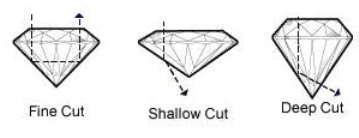
Fine or Well Cut Diamonds
When a diamond is cut to proper proportions, light is reflected from one facet to another and then dispersed through the top of the stone. Within the Well Cut standards are the sub categories of Ideal, Excellent, and Very Good.
Shallow Cut Diamonds
When the cut of a diamond is too shallow, light escapes through the pavilion before it can be reflected.
Deep Cut Diamonds
When the cut of a diamond is too deep, some light escapes through the opposite side of the pavilion.
 Why Diamond Cut is Important
Why Diamond Cut is ImportantDid you know that if the diamond is poorly cut, the colour and clarity can not make up for it? The cut of a diamond is what makes a rough diamond sparkle and shine. If a diamond is poorly cut, the light that enters the diamond from above will leak out of the sides and bottom of the stone, and the diamond will not have the optimum amount of sparkle or fireregardless of its colour or clarity.
Diamond cut is perhaps the most important of the four Cs, so it is important to understand how this quality affects the properties and values of a diamond. When a diamond is well-cut, light enters through the table and travels to the pavilion where it reflects from one side to the other before reflecting back out of the diamond through the table and to the observer's eye. This light is the brilliance and it is this flashing, fiery effect that makes diamonds so attractive.



In a poorly cut diamond, the light that enters through the table reaches the facets and then 'leaks' out from the sides or bottom of the diamond rather than reflecting back to the eye. Less light reflected back to the eye means less brilliance.
The way a diamond is cut, its width, depth, roundness, size and position of the facets determine the brilliance of the stone. Even if the color and clarity are perfect, if the diamond is not cut to good proportions, it will be dull and less impressive to the eye.
Don't confuse diamond "cut" with "shape." Diamond shape refers to the general outward appearance of the diamond, such as round, emerald, or pear.
 Ideal Cut Diamonds
Ideal Cut DiamondsYou may have heard of a term called "Ideal Cut". This term refers to the attempt to cut a round diamond into the best proportions to achieve maximum brilliance, fire and scintillation.
In order to cut a stone to ideal proportions, much of the rough diamond is sacrificed, leaving a stone with a smaller carat weight. Diamond cutters sometimes sacrifice ideal proportions to end up with a larger, more profitable stone. Industry standard valuation of diamonds (Rapaport) does not take into account a diamond's proportions, thus a larger diamond with fair proportions will be worth more than the smaller diamond with good proportions to a diamond cutter (colour and clarity being equal). Consequently, ideal cut stones are rarer and harder for wholesalers and jewellers to find and they are priced accordingly.
The diamond grading laboratories have been researching cut proportions for many years but there is still no industry agreement on what constitutes the best cut parameters for round brilliant diamonds.
It is hard for most diamond shoppers to understand diamond cut and what is "Ideal". There are straightforward standards for colour and clarity grading diamonds, but the diamond industry and diamond grading laboratories do not have a set standard when it comes to cut grading, proportions and what constitutes an "Ideal" cut diamond.
The term "Ideal" Cut Diamond or "American Ideal" Cut is a widely and quite oftenly misused marketing term used by Jewellers and Diamond Dealers to describe a cutting style based on proportions rather than an actual "Ideal" grade by a laboratory.
The American Gem Society - AGS adapted proportional ranges for their "Ideal" (zero, 0, best) cut grade, which was based on Marcel Tolkowsky's published thesis entitled, "Diamond Design: A Study of the Reflection and Refraction of Light in Diamond", a theoretical work describing the best proportions of a round brilliant diamond which would provide a balanced return of light (brilliance) and dispersion. These proportion ranges have been adapted and chnaged over the years.
Because all diamond grading laboratories use different names for their cut grades and a different set of parameters for their top cut grades, usually Excellent, Ideal or AGS0, the best way to compare a diamonds cut grade is by the individual proportions listed on the diamond certificate - Table%, Depth%, Crown Height, Crown Angle, Pavillion Depth, Pavillion Angle, Girdle & Culet.
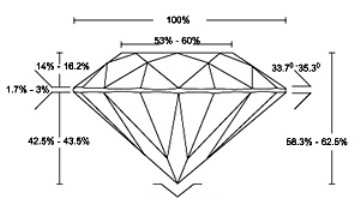
 Proportions for Diamond Cuts
Proportions for Diamond Cuts
Round Cut Diamonds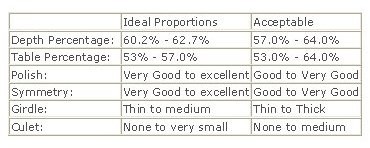 |
Oval, Pear, Marquise & Heart-Shaped Diamonds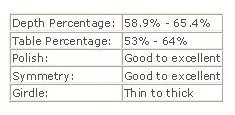
|
Emerald & Radiant Cut Diamonds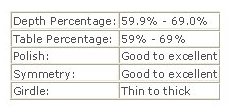 |
Princess Cut Diamonds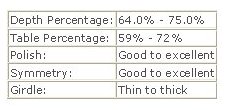
|
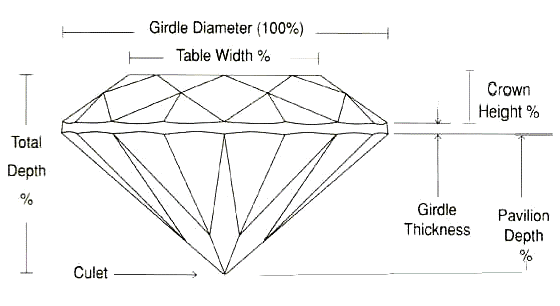
 Diamond Cut Paramaters
Diamond Cut ParamatersIn a round cut diamond, measurements are generally listed as maximum diameter, minimum diameter and total depth. The average of the first two measurements is the real "size" of a diamond. Deeper diamonds will usually have a slightly smaller diameter than diamonds that are spready cut stones, regardless of the diamond shape. In fancy cut diamonds such as an emerald or marquise cut, the measurements are generally listed as length, width, and depth. By dividing the length by the width we can calculate the "Length/Width" ratio for a fancy shape diamond. Different cutting styles have different preferred ranges, but this ratio is primarily a matter of taste.
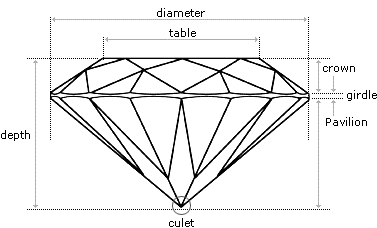
Depth %
Table %
This number indicates the size of the large flat facet located at the top center of the diamond. If the table facet on a diamond is very large, it may be a sign of a diamond that was cut in order to maintain maximum weight instead of maximum sparkle. Table Percentage is one of most important aspects in determining the final "beauty" of a diamond.Polish
This characteristic refers to the finishing or final polishing of the facets, or flat surfaces.The polish of a diamond is generally defined as either Poor, Fair, Good, Very Good, or Excellent. When purchasing a diamond, select one with a polishing grade of Good or above. Many people wrongly believe that "Very Good" or "Excellent" polish ratings will make a diamond visibly more brilliant or dispersive. The diamond cutter carefully polishes every facet on the diamond to shine and be free from polishing imperfections. Polish is a minor aspect in determining the final beauty & value of a diamond.Symmetry
Symmetry refers to how well the diamonds facets are aligned and "pointed". GIA defines symmetry as "the exactness of shape and placement of facets". Diamonds with a symmetry rating of "Poor" or "Fair" often times suffer from external imbalances such as an off-center or tilted table, off-center culet, misshapen facets, or wavy girdle. Diamonds with ratings of "Good" or better are most preferred. Symmetry ratings are more important than polish, but not nearly as important as depth and table. The symmetry of a diamond is generally defined as either Poor, Fair, Good, Very Good, or Excellent. When purchasing a diamond, select one with a symmetry grade of Good or above.
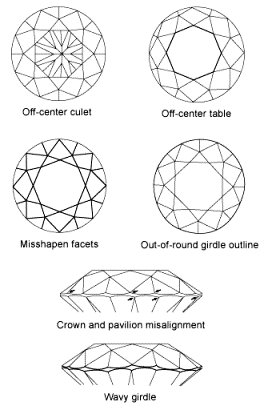
Girdle
The girdle is the outer edge of a diamond. It usually has a frosted appearance. Many diamonds are also finished with a fully polished or even a faceted girdle. This characteristic does not affect the value of a diamond and is often more a reflection the diamond cutter's preference. The girdle is rated in terms of thickness. Girdle size is generally defined as either Extremely Thin, Very Thin, Thin, Medium, Slightly Thick, Thick, Very Thick, or Extremely Thick. The girdle can also be described as a range of these terms such as Thin to Thick. When purchasing a diamond, select one with a girdle that is neither Extremely Thin nor Extremely Thick.Culet
The culet is the point at the bottom of the diamond. Most diamonds today do not have a culet (meaning all the facets come to a sharp point). Culet sizes from none to very small are most preferred, since larger culets can leak light out the bottom of the diamond. The culet is generally graded as None or Pointed, Very Small, Small, Medium, Slightly Large, Large, Very Large, and Extremely Large. Smaller is more desirableFacets
A diamond's ability to reflect light determines its display of fire and brilliance. Diamonds are usually cut with 58 facets, or separate flat surfaces. These facets follow a mathematical formula and are placed at precise angles in relation to each other. This relationship is designed to maximize the amount of light reflected through the diamond and to increase
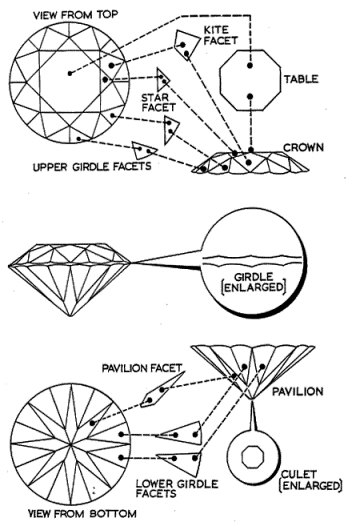
 Diamond Cut Grade
Diamond Cut GradeThe overall cut grade of a diamond is determined by taking into account all of the factors described above and plotting the results into a table. The lowest score becomes the overall cut grade of the diamond. When classifying a diamond with an overall finish grade - the lowest assigned grade for any individual characteristic is always used. For example: If the table percentage falls within Ideal yet the depth percentage is in the Very Good range, the diamond is classified as Very Good.
Gemologists agree that the best cut diamonds are those that follow a set of formulae calculated to maximize brilliance. These formulae can be seen in a diamond's proportions, most importantly how the depth compares to the diameter, and how the diameter of the table compares to the diameter of the diamond.
However, the variance in the proportions between an Ideal Cut and a Poor Cut can be difficult to distinguish by an untrained eye. Because cut is so important, several grading methods have been developed to help consumers determine the cut, known as the finish grade, of a particular diamond. In general, these grades are:
Ideal Excellent Very Good Good Fair Poor
Selecting the grade of cut is really a matter of preference. To make the best selection, you need to understand the various diamond finish grades. Please note that the descriptions below are general guidelines for the finish grade of a diamond's cut.Ideal Cut Diamonds
The Ideal cut diamond is designed to maximize brilliance, and with the typically smaller table size these diamonds have the added benefit of creating a great deal of dispersion or 'fire' as well. Ideal quality diamonds are truly for the person who enjoys knowing that they have one of the finest quality diamonds that money can buy. The Ideal cut category applies only to round brilliant cut diamonds.Excellent Cut Diamonds
In the case of round diamonds, many Excellent Cut diamonds have cuts that are the equal of any Ideal Cut diamond, though they often can be purchased at slightly lower prices than Ideal Cuts. Excellent cut diamonds are intended to provide maximum brilliance and fire. Like the Ideal Cut, these are also for the person who enjoys knowing that he has one of the finest diamonds that money can buy.Very Good Cut Diamonds
Very good cut diamonds reflect most of the light that enters them, dispersing a good deal of brilliance. With these diamonds, the diamond cutters have chosen to stray slightly from the preferred diamond proportions in order to create a larger diamond. The result is that these diamonds fall slightly outside of some proportions for table size or girdle width, however, in many cases most of the parameters of diamonds in this range will overlap with certain parameters of diamonds in the Ideal or Excellent cut ranges. Generally, the price of these diamonds in slightly below that of Excellent cut diamonds.Good Cut Diamonds
Good cut diamonds are diamonds that reflect most of the light that enters them. Their proportions fall outside of the preferred range because the diamond cutter has chosen to create the largest possible diamond from the original rough crystal, rather than cutting extra weight off to create a smaller excellent cut quality diamond. Diamonds in this range offer excellent value for people who want to stay in a budget without sacrificing the quality or beauty of the diamond.Fair & Poor Cut Diamonds
A diamond graded as fair or poor cut reflects only a small proportion of the light that enters it. Typically these diamonds have been cut to maximize the carat weight over most other considerations.
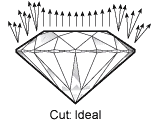
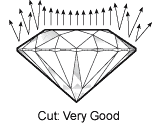
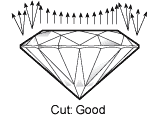
 Comparing Diamond Cut Grades
Comparing Diamond Cut GradesNOT ALL LABORATORIES GRADE TO THE SAME CUT GRADE PARAMETERS
The table below details the various laboratories and the different grading scales they use, you will notice that there is an over lap in some of the grades and that the top grade is not the same for each laboratory.

DCLA & GIA have the same grade categories except DCLA calls its second lowest grade Medium whereas GIA calls it Fair. AGS has the same breakdown of catgeories as both DCLA & GIA except for the top grade of Excellent where it breaks down that category into two sections of Ideal - AGS0 and Excellent - AGS1.
AGS is the only Grading Laboraotory that actually has a grade called Ideal. The term Ideal Cut Diamond is a widely and quite oftenly misused marketing term used by Jewellers and Diamond Dealers to describe a cutting style based on proportions rather than an actual Ideal grade by a laboratory unless the diamond has been certified by AGS with and AGS grade of Ideal - AGS0.


 Diamond Colour
Diamond Colour